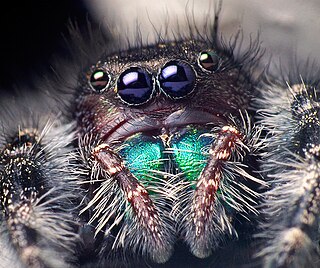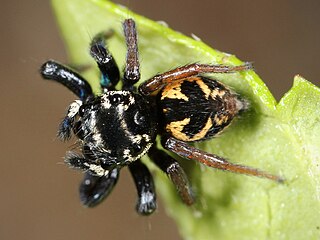
Phidippus is a genus in the family Salticidae. Some of the largest jumping spiders inhabit this genus, and many species are characterized by their brilliant, iridescent green chelicerae. Phidippus is distributed almost exclusively in North America, with the exception of two exported species. As of January 2021, there were about 80 described species in the genus. Species previously described in Phidippus which are found in India and Bangladesh do not belong in this genus.

Habronattus is a genus in the family Salticidae. Most species are native to North America. They are commonly referred to as paradise spiders due to their colorful courtship ornaments and complex dances, similar to birds-of-paradise.

Anasaitis is a genus of jumping spiders that was first described by E. B. Bryant in 1950. The name is derived from the salticid genus Saitis.
Ashtabula is a genus of jumping spiders that was first described by G. W. Peckham & E. G. Peckham in 1894.

Beata is a genus of jumping spiders that was first described by George Peckham & Elizabeth Peckham in 1895.

Corythalia is a genus of jumping spiders that was first described by Carl Ludwig Koch in 1850.

Messua is a spider genus of the family Salticidae.

Metaphidippus is a genus of jumping spiders that was first described by Frederick Octavius Pickard-Cambridge in 1901. The name is combined from Ancient Greek μετά "after, beside" and the salticid genus Phidippus.

Pachomius is a genus of jumping spiders that was first described by George and Elizabeth Peckham in 1896. Uspachia was merged into genus Romitia in 2007, and all nine species were merged into Pachomius in 2015. The name is derived from Pachomius, the founder of cenobitic monasticism.

Pelegrina is a spider genus of the family Salticidae. They are found throughout North America. Many of the species in Pelegrina were previously placed in the genera Metaphidippus, and before that, Dendryphantes. The genus was originally described in 1930 by the Spanish arachnologist Pelegrín Franganillo Balboa, who named it after himself.

Sassacus is a genus of jumping spiders that was first described by George and Elizabeth Peckham in 1895. It is likely named after Sassacus, a Native American chief of the 16th and 17th century.
Selimus is a monotypic genus of Brazilian jumping spiders containing the single species, Selimus venustus. It was first described by George and Elizabeth Peckham in 1901, known from a single male found in Brazil. The species name is derived from Latin venustus "charming".
Sidusa is a genus of jumping spiders that was first described by George and Elizabeth Peckham in 1895.

Zygoballus is a genus of jumping spiders found in North and South America.

The Dendryphantina are a subtribe of jumping spiders that occur mainly in the New World. The subtribe was first defined by Anton Menge in 1879 as Dendryphantidae. Females of the subtribe generally show paired spots on the abdomen, and the males often have enlarged chelicerae. Females in this subtribe typically have S-shaped epigynal openings.

Euophryini is a tribe of jumping spiders. It has also been treated as the subfamily Euophryinae.
Metaphidippus pernix is a species of spider in the Salticidae family found in Guatemala.
Nigorella manica is a species of spider in the family Salticidae, found in Zimbabwe.

Habronattus mexicanus is a jumping spider species in the genus Habronattus. It is the type species of that genus.













